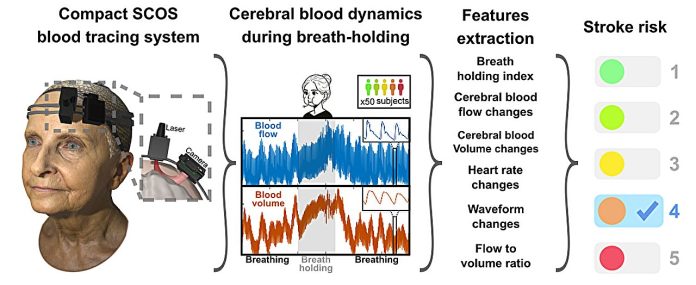
Researchers from the Keck School of Medicine of USC and the California Institute of Technology (Caltech) have developed an innovative, noninvasive device that could make it easier to detect a person’s risk of stroke.
The device, which is worn like a headband, uses a special technique called speckle contrast optical spectroscopy (SCOS) to measure blood flow in the brain.
This new tool could transform stroke care, helping doctors identify stroke risk early and easily, similar to how cardiac stress tests help assess heart health.
Strokes are the leading cause of long-term disability worldwide, with most caused by blockages in blood flow to the brain.
Currently, stroke risk is often determined by lifestyle and family history rather than direct physical signs, making it difficult to predict who might be at risk.
The new headband device could change that by providing a simple, cost-effective, and portable method to assess stroke risk.
“If we can develop a brain stress test that is affordable, scalable, and noninvasive, it could make a huge difference in public health,” said Dr. Charles Liu, a professor at the Keck School of Medicine and one of the study’s lead researchers.
In their study, published in Biomedical Optics Express, Liu and his team tested the device on 50 participants.
The test involved wearing the headband while performing a breath-holding “stress test” for the brain.
Holding the breath briefly increases pressure in the brain, allowing researchers to see how well the brain’s blood vessels handle the stress.
The SCOS device measured blood flow and volume changes in the brain during this test.
The results showed that the device could distinguish between people with low and high stroke risk based on how their blood flow responded to the stress test.
This discovery suggests the headband device could be a useful tool for assessing stroke risk.
The researchers used a common stroke risk questionnaire, the Cleveland Clinic Stroke Risk Calculator, to identify participants with low and high stroke risk.
They then compared the headband’s results to this questionnaire and found that the SCOS device accurately reflected stroke risk.
One of the biggest advantages of the new device is that it is much simpler and more affordable than traditional brain scans, like MRIs or CT scans.
Since the headband device is portable and easy to use, it could be deployed in primary care offices, emergency rooms, and even clinics in developing countries.
The next step for the research team is to refine the device and test it on a larger group of people over a longer period. They also plan to use machine learning to improve how the device interprets data and predicts stroke risk.
This headband-like device has the potential to become a routine part of annual physical exams, allowing for early detection and better prevention of strokes, ultimately saving lives and improving public health.
If you care about stroke, please read studies about how to eat to prevent stroke, and diets high in flavonoids could help reduce stroke risk.
For more information about health, please see recent studies about how Mediterranean diet could protect your brain health, and wild blueberries can benefit your heart and brain.
Source: USC.



